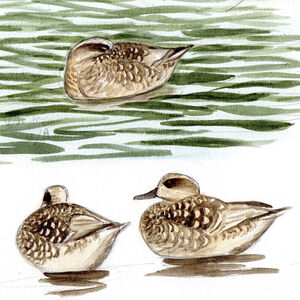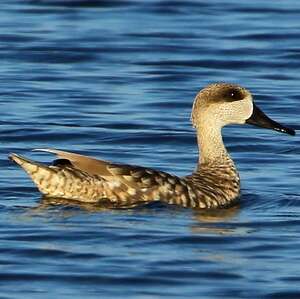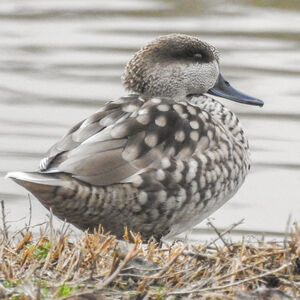Marbled Duck
Marmaronetta angustirostris - Sarcelle marbrée Marmaronette marbrée
Identification
The Marbled Duck is a small duck of the same size as a summer teal. It has long wings and a long tail giving it a graceful look. The dark beak is quite narrow. The legs are also dark in color. It has a light gray-brown body with distinct creamy spots on the top due to the brownish back. It has a dark comma near the eye and a crest which extends over the nape. In flight its wings are light and only a white patch at the wrist on the anterior edge of the wing and the absence of a mirror can be used to identify it.
Both sexes and immatures are almost similar. However the female is slightly smaller, the male has a more abundant crest and a darker beak and juveniles have less distinct spots.
Subspecific information monotypic species
Foreign names
- Sarcelle marbrée,
- Cerceta pardilla,
- pardilheira,
- Marmelente,
- márványos réce,
- Marmereend,
- Anatra marmorizzata,
- marmorand,
- Marmorand,
- kačka úzkozobá,
- čírka úzkozobá,
- Marmorand,
- marmorisorsa,
- xarxet marbrenc,
- Dropönd,
- marmurka,
- marmora krīklis,
- marmorna raca,
- Мраморный чирок,
- ウスユキガモ,
- 云石斑鸭,
- 雲石斑鴨,
Voice song and call
Habitat
This small duck is very rare and localized. It can be found in shallow, densely vegetated ponds. Although it enjoys brackish marshes, too high a salinity is not suitable for it.
Behaviour character trait
Dietfeeding habits
The Marbled Duck is mostly vegetarian but it does not disdain invertebrates (Heteroptera, Diptera, Coleoptera and Ostracodes). Diptera is a major component of their diet before and during the breeding season. After this period it is mainly the small seeds (Scirpus) that are sought. Chicks are heavily dependent on the appearance of Chironomes.
Reproduction nesting
Geographic range
The populations of the Marbled Duck have a fragmented distribution in the Western Mediterranean (Spain, Morocco, Algeria, Tunisia, wintering in Western and Sub-Saharan Africa), Eastern Mediterranean (Turkey, Israel, Jordan, Syria, wintering in southern Egypt) and Western and Southern Asia (Azerbaijan, Armenia, Russia, Turkmenistan, Uzbekistan, Tajikistan, Kazakhstan, Iraq, Iran, Afghanistan, Pakistan, India and China, wintering in Iran, Pakistan and northwest India).
Threats - protection
IUCN conservation status
concern
in the Wild
threatened
evaluated
This species appears to have rapidly declined in population at the very heart of its distribution area, due to numerous and significant destructions of its habitat. Therefore, it is considered Vulnerable. However, the scarcity of data might be explained by bird movement to other sites. The apparent increase of population in the western Mediterranean probably reflects the increased pressure of observation more than the trend reversal.
The proposed conservation measures are geared towards a better knowledge of its ecology, protection of all the sites where the species is regularly present, reducing mortality due to hunting or other causes, and raising public awareness. The species is legally protected in Bulgaria, Israel, Morocco, Spain, Russia, Tunisia and Turkey. The Marbled Duck is also known as the Sarcelle marbrée.
Sources of information
- IOC World Bird List (v15.1), Gill, F and D Donsker (Eds). 2025-12-07.
Other sources of interest
 Specification sheet created on
03/08/2023 by Jean-Pierre Trouillas
Specification sheet created on
03/08/2023 by Jean-Pierre TrouillasTranslation by AI Oiseaux.net
© 1996-2026 Oiseaux.net
- Accipitriformes
- Aegotheliformes
- Anseriformes
- Apodiformes
- Apterygiformes
- Bucerotiformes
- Caprimulgiformes
- Cariamiformes
- Casuariiformes
- Charadriiformes
- Ciconiiformes
- Coliiformes
- Columbiformes
- Coraciiformes
- Cuculiformes
- Eurypygiformes
- Falconiformes
- Galliformes
- Gaviiformes
- Gruiformes
- Leptosomiformes
- Mesitornithiformes
- Musophagiformes
- Nyctibiiformes
- Opisthocomiformes
- Otidiformes
- Passeriformes
- Pelecaniformes
- Phaethontiformes
- Phoenicopteriformes
- Piciformes
- Podargiformes
- Podicipediformes
- Procellariiformes
- Psittaciformes
- Pterocliformes
- Rheiformes
- Sphenisciformes
- Steatornithiformes
- Strigiformes
- Struthioniformes
- Suliformes
- Tinamiformes
- Trogoniformes



























